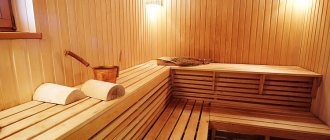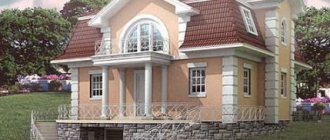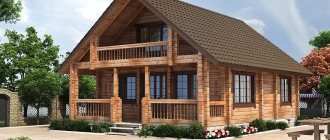A fence is a fence that gives the owner of a suburban area a sense of security and prevents strangers from entering the yard and seeing what is happening in it. The mistake of many summer residents and residents of villages is that they do not observe the permitted distance from the house to the fence, and this is a violation of construction standards. How to comply with these standards when building a fence?
Features of fencing installation
The fence has the following functions:
- separate the land plot from the road and neighboring territory, eliminate land disputes;
- protect objects and objects located on the territory from road dust, exposure to wind, and debris;
- hide the activities of the owner of the site from prying eyes;
- make it more difficult for intruders to enter the territory of individual housing construction;
- act as a decorative component that is combined with other structures on the site;
- mark the boundaries of the territory in order to comply with regulations in accordance with the law and all regulations.
Permitted distance between adjacent railway lines
If you are starting to build a house on a site where people already live next to it, you need to take into account the existing buildings before starting work.
SNiP states that the distance between railways is based on the materials used in their construction:
- If your neighbors' house is made of wood, you can place yours at least 15 meters apart. If it is brick, stone or concrete, then 10 meters is enough.
- The minimum gap between two brick railways with a wooden roof is 8 meters.
- 6 meters is the gap between railways built from non-combustible materials.
- The distance between 2-3-storey railways is from 15 meters.
PB does not set strict requirements for the creation of additional NPs inside a private yard.
Distance between adjacent individual housing construction
Types of fences
Today there is a wide selection of building materials from which you can build a fence for your site. Let's look at the main fence options:
- panel Installation is carried out from boards fixed to a frame made of timber. The structure has a rectangular shape with a standard length of 1.8 m. The boards can be positioned both vertically and horizontally. Shields can be purchased or assembled yourself. To extend the service life of such a fence, it is treated with anti-rotting agents and provides fire protection. The most popular material is pine;
- trellis. Mainly performs a decorative function. Structurally, the fence is built from wooden slats, forming squares. Such a fence also needs additional protection;
- palisade The stakes are driven next to each other. You can use steel wire for reinforcement. The fence is quite durable, but the appearance is not for everyone;
- chain-link It is often used as a material for fencing areas near outbuildings. In urban environments it will not be the best option, since the area will be completely visible;
- fence. This option is often used both for flowerbeds and has a small height, and for fencing a plot of land, covering it from the street side. The structure consists of horizontal beams, to which wooden planks are vertically attached.
What distance should buildings be from the fence?
It is popular to buy large plots of land, then survey them, divide them, and sell them to different people, so you can often see cottages standing close to fences, because sometimes there is not much free space. However, there are regulations governing the location:
- The distance to the fence in the established order is less than 3 m, this is dictated by the relevant documents and common sense, because any buildings have to be maintained.
- Even when there is an agreement with a neighbor that he is not against nearby buildings, the situation may change, and then the matter will inevitably end in litigation. This takes a lot of time, money, and the court always takes the side of whoever is right according to the law, so the owner of illegal structures can pay with fines, or less often with an order for demolition.
When deciding to buy a plot for building a cottage, it makes sense to first familiarize yourself with all the rules, regulations, permits, and prohibitions associated with this process. Compliance with simple instructions will help you avoid problems with the law and neighbors. It is also worth seriously observing fire safety standards, which are important primarily for the owner of the site, because fires, pollution, and other problems unnecessary for the owners. Compliance with building codes is a guarantee of the health of the owners, as well as their property.
Rules and regulations for the location of residential buildings on the site
If a residential property is built at an arbitrary distance from a neighbor’s fence, this may serve as a reason to go to court. Local authorities will have the right to force the removal of the structure. The gap between housing and fencing lies in specific numbers that should be taken into account during the planning process.
If the necessary indents are taken into account, then no questions will arise according to SNiP.
How to determine optimal indents
The distance from the fence to the neighbor’s buildings at the dacha house is determined by the relevant standards:
- the red line requires that an individual building be located at least 5 m from it. If it is only a passage, then 3 m will be enough;
- the gap from the house to the fence must be at least 3 m, provided that the measurements were carried out taking into account all the points provided for by the rules;
- outbuildings should be located at a distance of 4 m from housing;
- the bathhouse building is built at least 3 m from the neighbor’s border;
- barn, garage or toilet - at least 1 m. The same values should be followed when planting low-growing plants;
- trees are planted 2-4 m from the enclosing structure, which is determined by their height.
Distances according to fire requirements
If a plot of land was purchased for development in the private sector, and people already live in the neighborhood, then before starting construction work, you should take into account the existing facilities. In addition, you need to know about the permissible minimum distance from the house to the fence between neighbors, which is also determined by the material of the buildings:
- if you plan to build housing from wood, and next door there is a house made of similar material, then you should retreat 15 m, but if construction is carried out from stone, concrete or brick - 10 m;
- if the material of both houses is brick or concrete, and wood is used as a ceiling, then the distance between them should be 8 m;
- if houses are built from fire-resistant building materials without wooden elements, then the gap can be 6 m;
- houses with several floors are located at a distance of at least 15 m.
Engineering Requirements
The slope of the roof of the house must be at least 1 m from the neighbor’s allotment. If for some reason it is impossible to comply with this parameter, then the drainage system should be installed in your direction. In addition, housing must be equipped with a ventilation system and an electric meter.
Sanitary standards and requirements
According to sanitary standards, facilities are located as follows:
- bathhouse building 8 m from housing;
- a similar interval is maintained from the compost and toilet to the well;
- from agricultural buildings to the house - 12 m.
Gaps from the fence to the roadway
According to SNiP, the following setbacks to the road are defined:
- at least 2 m to the road;
- more than 5 m to the roadway.
The entry of a car into its territory should be convenient, and two meters is sometimes not enough for the smooth passage of a vehicle. Therefore, it is worth thinking about installing fences at a distance of more than 2 m from the road.
What to consider before planning
The development of the site is preceded by the planning of buildings in the future yard. To do this, draw up a scaled drawing with the required dimensions. The scheme will allow you to place business and housing facilities, taking into account the rules of how many meters to retreat from the fence to build a house, what gaps must be maintained between other buildings.
The layout is carried out before the project is approved, and the drawing will be needed when obtaining a construction permit. The layout can be ordered from the relevant organizations or done independently. It is necessary not only to make a drawing of the site with buildings, but to arrange them so as to take into account the requirements of construction, plumbing, fire safety and other standards.
What requirements need to be taken into account when developing a site?
Approximate site development plan
Initially, the boundaries of the allotment are determined and a fence is erected to separate one’s own land from the adjacent or public area. The number of buildings and their dimensions are regulated by the local government. Standard development projects need to be modified in relation to specific conditions.
The site is divided into zones:
- residential;
- recreation;
- gardening;
- economic
The reference point for the location of buildings is the red building line, the highway, as well as the boundary with the nearby site. Each department has its own requirements, so during development they need to be coordinated so that the layout meets all.
Indentations depending on the type and number of storeys of the building
It is not allowed to build individual houses higher than three floors, but high-rise buildings can be approved by the architectural bureau of the city or region. The number of underground levels for a private house is not regulated.
The following distances are maintained between the long walls of the home:
- 2 - 3 levels high - 15 m;
- more than four floors - over 20 m;
- with windows from rooms and bedrooms - at least 10 m.
The standards are changed by the decision of the architectural department if difficult location conditions arise and reconstruction is required. In this case, standards of illumination, insolation, and fire safety requirements are taken into account.
Facade fence, roadway and other nuances
The design of a 3-story house is coordinated with the neighbors, whose plot may be in shadow most of the day
In non-profit gardening associations, the board may recommend face fence height, design and material. If the height of the street fence is higher than 2 meters, you need to obtain permission from the architecture of the city or town.
Sometimes there is not enough land to meet all the requirements for spacing between buildings. The only way out is the approval of non-standardized planning by local authorities. Neighbors can file a lawsuit if the shadow of a three-story house covers the garden for almost a day, so houses must be built taking into account the interests of other owners.
The distance to the roadway can also be adjusted in the architectural office. Approaching the red line reduces the path to the door of the house in bad weather, but increases the audibility of sounds from passing vehicles. The close location allows passers-by to look at the interior of the home through the windows.
Fence height between areas
When considering the question at what distance from the fence it is possible to legally build a house on a summer cottage in accordance with SNiP standards in SNT and individual housing construction, an important point is also the height of the fence. You should maintain a height of 1.5 m, which will prevent shading of your neighbor’s plot. These numbers may vary for each region.
If it is necessary to build a fence higher than 2 m, you should contact the chief architect for the relevant document. It is not recommended to build such a structure spontaneously, as this may result in a lawsuit. To avoid reasons for demolishing the fence, it is easier to install it on the street side with a height of up to 1.5 m.
Standards for planning distances from the fence
When separating your home from the street and neighboring buildings, you cannot be guided only by your preferences and personal wishes. There are a number of documents that formulate standards for installing fences. The most important one is SNiP No. 441, developed in 1972. According to it, the maximum permissible height of a fence between neighbors is 1.5 meters, and an external fence is 2.2 meters. Each local administrative body, at its own discretion, usually makes adjustments regarding this value, based on the needs, specifics of the region, each area has its own architectural requirements. Therefore, before erecting fences, it is necessary to check with local municipal authorities about the permissible height parameters.
There are also fire regulations that regulate the installation of structures around areas that regulate safety standards in the event of an open fire. When buildings are “crowded”, there are trees and wooden structures, a potential fire can spread very quickly throughout the area, especially in summer.
The presence of sanitary recommendations is due to air, soil, water pollution, the spread of unpleasant odors, and the appearance of pests. The question concerns sheds, cesspools, pens for year-round keeping of small livestock, and kennels for small animals. There is always a certain distance between a residential building and this object, which is also regulated by SNiP. In other words, from the base of the structure to the protruding part there is a certain footage when the size exceeds 50cm.
It is impossible to violate the requirements of the law, otherwise problems will arise with neighbors, legal proceedings, and legal orders for demolition. That is why it is important to study SNiP standards before starting construction in order to avoid further problems.
Requirements for distances in SNT
SNT is a horticultural non-profit partnership. Development in such areas is regulated by SNiP 02/30/97. But sometimes such organizations have their own charter, which is approved by the relevant authorities. There are cases when land plots can be left without fences at all.
The height of the fence on the street side should not be more than 2.5 m. There are no restrictions regarding materials. Fencing between neighboring land plots is made up to two meters high using materials that can transmit light. Independent removal of the fence by one of the parties is prohibited.
If the farm buildings of both neighbors are located nearby, then with the permission of the neighbors you can enter their land. However, there are obstacles for the passage of residents or the passage of vehicles, etc. should not be created.
Since the fence is being built for a long time, it would be useful to record the agreement between neighbors in writing and have it certified by a notary.
Distance from the building to the fence in front of the neighbor's windows
If the fence is located directly next to the neighbors' windows, relationship problems will arise over time. Each window must have a certain level of visibility, so it is important to understand the maximum allowable height when separating an area.
If the structure is made of lattice or mesh, the height limit is 1.5 meters. A blind fence should not exceed 70 cm. Sometimes the height of the fences does not correspond to these parameters, it is worth taking written permission from the neighbors, because if it reaches the proceedings, it will help defend the construction. If the materials are blind and translucent, you can increase the height to more than 70 cm but less than 1.5 meters without official permission from third parties. This rule has a regional amendment.
Sometimes fences are installed above the existing level; these violations provoke flooding of neighboring yards during rainstorms. It is necessary to make a drainage system, otherwise the structure may be ordered to be demolished.
Board fencing can be installed without additional approval, observing the rarity of vertical bases of 50%.
An important point of all regulations is the safety of the organization of fences, secured at the appropriate level, without protruding sharp parts. Capital fences are erected after the cadastral chamber has clearly defined the boundaries of the yard, but before this, non-permanent structures, for example, made from chain-link mesh, can be used.
Residential building in the village of individual housing construction
If you compare plots in SNT, then owners of land in individual housing construction adhere to different documents - SP 30-102-99. For low-rise buildings, the gaps between houses in individual housing construction and SNT are similar, but there are certain differences:
- from the windows of a residential property to the walls of a house or other neighboring buildings - 6 m;
- It is prohibited to erect agricultural buildings and garages in the form of detached buildings - they should be attached to a residential building.
Rules for appealing the installation and resolving disputes in court
If the placement of a toilet on a plot of land is planned incorrectly, or the norms are violated, a neighbor can file a complaint in court. A common cause is the entry of sewage into the site.
All standards for the placement of buildings are established by SNiP “Planning and Development of Urban and Rural Settlements” PHOTO: severny.by
In this case, an inspection will be ordered, and if the distance is violated, a fine and damages will be imposed. It is not advisable to initiate proceedings to challenge a decision if the problem is obvious. The minimum fine is 3 thousand rubles.
To protect his rights in court, the defendant can order an extract from the BTI with the footage of the site, and also prove that no errors were made when locating the utility premises.
How to maintain good relations with neighbors
In order to avoid disputes, courts and other proceedings with neighbors, before starting the construction of any structure, it is worth notifying them about it. You can solve the situation with the location of buildings such as a restroom, greenhouse or barnyard by co-locating yours and neighboring buildings.
So, if your territory borders on three sides with neighbors, then it would be quite reasonable to place restrooms in one place. The same applies to outbuildings for birds, farm animals, etc. In this way, it will be possible to avoid offense, and the cesspools can be cleaned together, which will be cheaper in cost. It will also not be a bad idea to jointly decide on the placement and construction of the fence.
The most common conflict situations include:
- a high solid fence, which creates a shadow for the windows and trees of the neighbors;
- illegal seizure of a neighbor's property by installing a fence;
- construction of objects near the border of the allotment that emit an unpleasant odor;
- construction of large houses on a small area.
You can avoid various quarrels and disagreements between neighbors only by knowing at what distance from the fence you can legally build a house on a summer cottage in SNT and individual housing construction in accordance with SNiP standards. Before starting construction, it is advisable to prepare a plan and go with it to the relevant authorities to clarify all the nuances. If there are any violations, specialists will definitely point them out.
Related publications
- Read
DIY fence painting
- Read
Installation of a plastic fence
- Read
Fence decor
- Read
DIY decorative fence
- Read
Do-it-yourself corrugated fence with brick pillars
- Read
At what distance from the fence can you build a house?
The range of installation of outbuildings today is very wide. Most cottage owners try to make the most of the available yard space to make it useful. Such structures are found in examples of garages, bathhouses, storage areas for gardening tools, summer kitchens, gazebos, sheds, chicken coops, and cattle pens. Regarding the fence, there are certain location standards:
- The storage area for gardening tools is located further than one meter; the slope of the roof should go inside the site.
- Between animal pens, greenhouses, plantings that include organic fertilizer, relative to the boundaries of the neighboring plot is 4 m. Such requirements also meet sanitary and epidemiological requirements, since they can emit an unpleasant odor, especially in summer.
- No premises with increased fire hazard, for example, summer kitchens, boiler rooms, baths, should be built closer than 5 meters. Such structures violate existing standards, so non-compliance can provoke fines, even demolitions.
- Showers and toilets, also due to sanitary standards and humidity, are located further than 2.5 meters; canopies and slopes must necessarily face the courtyard of the owners of the buildings.
- From the center of the trunk of spreading trees to the edge of the site, the distance is set to less than three meters. Such plantings are a stumbling block between most neighbors, since branches can interfere with someone else’s site, for example, with crumbling inflorescences.
- Trees of medium height are planted further than 2m, shrubs – 1m. At the same time, you need to carefully monitor the freshness of the plantings, because dried out plantings can also lead to a lawsuit for non-compliance with fire safety.
Video: site arrangement according to GOST
Of course, there are situations when land plots are so small that their area simply does not allow compliance with all the rules for the mutual placement of buildings. In this case, you can solve the problem by using the services of BTI specialists who know all the subtleties and nuances. Otherwise, if conflicting issues arise, you will have to involve lawyers.
- Author: limon4ik2013
Rate this article:
- 5
- 4
- 3
- 2
- 1
(65 votes, average: 3.9 out of 5)
Share with your friends!
General information
Features of fence installation work
The fencing will have the following functions:
- Separate the plot of land from the road, territories that are nearby and eliminate land disputes.
- Protect objects and objects that are on the site from road dust, wind and debris.
- Hide the work process of a suburban area from prying eyes.
- It is important to make it more difficult for intruders to enter individual housing construction lands.
- Play the role of a decorative part that will be combined with the rest of the buildings on the countryside.
- Separate territorial boundaries in order to comply with laws and regulations.
Let's look at what types of fences there are.
Types of fences
At the moment, there is a huge selection of building materials from which it is possible to build a fence for the site. Look at the main fence options:
Panel - installation is carried out from boards that are attached to a frame made of timber. The design has a rectangular shape with a typical length of 1.8 meters. The boards can be positioned horizontally/vertically. Shields can be purchased or assembled with your own hands. To increase the service life of such a fence, coat it with anti-rotting compounds, providing protection from fire. The most popular option was pine.- Trellis - most often it plays a decorative role, and structurally the fence is built from slats of wood, with the production of squares. This fence still needs a high degree of protection.
- Palisade - pegs should be driven in next to each other, and steel wire can be used for strengthening. The fence has a good degree of strength, but the visual appearance is for amateurs.
- Chain-linking is often used as a means to protect the territory near outbuildings, and in a city environment it would not be the best option, since the place will be fully visible.
- Fence - this option is often used for flower beds and has a small height, and also for fencing a plot of land, covering it from the street side. The structure is made of horizontal bars to which wooden planks are vertically attached.
More expensive works include fencing made of profiled sheets, bricks, forged elements and stones. Such fences are durable and reliable. It is possible to use barbed wire, but not lower than 2 meters from the ground. If the fence is built between the territories of two vegetable gardens, then the height should be such as not to block light access and not to disrupt air exchange. For this reason, the best materials will be picket fence and chain-link. Sometimes you need to get permission to install a fence:
- If the boundaries of the plot are not marked in the cadastral plan.
- If the territory borders on architectural monuments or industrial facilities.
- If the area is small, which may interfere with construction work in accordance with GOST.
You can build a house, but at what distance from the fence? If the fence is built between the territories of two vegetable gardens, then its height should be such as not to block light access and not to disrupt air exchange. For this reason, picket fence and chain-link will be the optimal materials. Sometimes you need to get permission to install a fence:
- If the site has a small area, which interferes with construction in accordance with GOST.
- When the territory borders on architectural monuments or industrial facilities.
- If the boundaries of the plot are not marked in the cadastral plan.
Next, we’ll talk about different standards for erecting a fence.
Compliance
To document destruction of housing construction, the developed documentation must meet the following standards:
- Construction - the distances between the fence and objects are indicated.
- Sanitary - determine at what distance from the border of the plot it is important to locate the building.
- Firefighters - determine the location of housing based on the materials of the load-bearing walls.
Let's look at the rules.
Why are standards needed?
Landing standards SNiP 2020 2019 solve several problems at once:
- there are no obstacles to extinguishing the fire;
- preservation of neighbor's rights
- preventing possible injuries from falling branches.
When planting plants, you need to pay attention to nearby buildings. Over time, the seedling grows taller and can snag power lines.
The problem of many summer residents is that they do not take into account many factors that can easily affect the appearance of the garden:
- A small seedling grows over time. Its crown is growing. It will affect not only your personal plot, but also the neighboring territory. Tall and powerful plants can snag electrical wires with their foliage.
- If you plant a tree with a strong root system near a building, over time it will open up the concrete.
- Damaged and dilapidated branches can break during natural disasters.
- In the fall, foliage falls onto the neighbor's territory (if you ignore the rules of SNiP).
Building codes
The 2020 building codes and regulations are advisory in nature; they should not be neglected, since all kinds of authorities that authorize the operation of buildings and structures are guided in their governing documents by the provisions contained in them.
Compliance with the requirements will reduce conflicts with your neighbor and the likelihood of receiving an administrative fine.
When choosing a fence design, you take into account not only your own taste, but also local government regulations and building regulations. The height of the fence is practically the main indicator. In addition to performing its direct functions, the fence should not disturb the neighbors.
Construction standards for the location of buildings on the site
The fence between areas is made of transparent materials so as not to obscure the adjacent land. Neighbors can agree on other options, but it is highly advisable to make such a transaction in writing; if the owner changes (or if disagreements arise), it will be the decisive argument for the court.
An opaque fence can only extend onto the roadway and public areas. Basic construction rules:
- The height of the part of the fence that extends into public areas can be up to 2.2 m.
- A transparent fence between areas can be erected to the same height; if you want a solid fence, then no higher than 75 cm.
- The fence should not extend beyond the property line more than 5 cm.
- To prevent your and your neighbor's property from flooding, a drainage system is needed.
An example of installing a drainage system on a site - If the fence is closer to the roadway than 1.5 m, then the gates are made to open inward.
The best option would be to visit local authorities to clarify all the parameters.
How to place a garden in a small area
A small area requires a lot of attention. It will be difficult to plant apple trees on it, since they require a large garden area. In order for seedlings to bear fruit, it is worth giving preference to dwarf varieties. Their height does not exceed 5 m. It is important that the trees must be commensurate with the size of the plot.
Professional gardeners advise planting large plants on plots of 6 acres. 4 apple trees are enough and the garden will be cozy. Be sure to keep an eye on their growth. Trim branches. If you take care of your garden, then every bush and tree will delight the eye of you and your neighbors.











